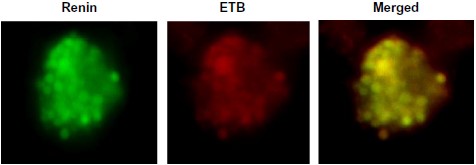Overview
- Peptide CEMLRKKSGMQIALND, corresponding to amino acid residues 298-314 of rat ET-B (Accession P21451). 3rd intracellular loop.

 Western blot analysis of rat brain membranes:1. Anti-Endothelin Receptor B Antibody (#AER-002), (1:200).
Western blot analysis of rat brain membranes:1. Anti-Endothelin Receptor B Antibody (#AER-002), (1:200).
2. Anti-Endothelin Receptor B Antibody, preincubated with Endothelin Receptor B Blocking Peptide (#BLP-ER002).
 Expression of EDNRB in rat lungImmunohistochemical staining of paraffin embedded section of rat lung using Anti-Endothelin Receptor B Antibody (#AER-002) (1:100). EDNRB is expressed both in respiratory epithelium (black arrows) and in respiratory smooth muscle (red arrows). Note that vascular smooth muscle is not stained (blue arrows). Hematoxilin is used as the counterstain.
Expression of EDNRB in rat lungImmunohistochemical staining of paraffin embedded section of rat lung using Anti-Endothelin Receptor B Antibody (#AER-002) (1:100). EDNRB is expressed both in respiratory epithelium (black arrows) and in respiratory smooth muscle (red arrows). Note that vascular smooth muscle is not stained (blue arrows). Hematoxilin is used as the counterstain. Expression of EDNRB in rat thalamusImmunohistochemical staining of rat dorsal peri-ventricular thalamus using Anti-Endothelin Receptor B Antibody (#AER-002). Cresyl violet is used as the counterstain.
Expression of EDNRB in rat thalamusImmunohistochemical staining of rat dorsal peri-ventricular thalamus using Anti-Endothelin Receptor B Antibody (#AER-002). Cresyl violet is used as the counterstain.- Mouse retina (1:100) (Rattner, A. and Nathans, J. (2005) J. Neurosci. 25, 4540.).
- Human endocardial endothelial cells (EECs) (1:100) (Jacques, D. et al. (2005) Peptides 26, 1427.).
- Human umbilical vein endothelial cells (1:200) (Yaiw, K.C. et al. (2015) Open Forum Infect. Dis. 2, ofv155.).
- Davenport, A.P. (2002) Pharmacol. Rev. 54, 219.
- Boivin, B. et al. (2003) J. Biol. Chem. 278, 29153.
- Grant, K. et al. (2003) Br. J. Cancer. 88, 163.
Endothelins (ET-1, 2, and 3) are considered to be very powerful vasoconstrictive substances. In humans, endothelins mediate their actions via two specific G-protein coupled receptors, ETAR and ETBR. Both ETAR and ETBR are present in the heart and in human myocardium at similar levels.1,2
The endothelin receptors differ in their ligand specificity. While ETAR has varying affinities for the endothelin isoforms (ET-1 > ET-2 > ET-3), ETBR shows no selective affinity.2,3
Subsequent studies have demonstrated the presence of endothelins in vascular, as well as in non-vascular, cells and tissues, having multiple biological activities.
Currently, there is increasing evidence that ET-1 may modulate mitogenesis, apoptosis, angiogenesis tumor invasion and the development of metastases.3
Until recently, it was thought that all cellular activities of the endothelins were mediated through their interactions with their cell surface receptors. However, a recent study demonstrated that cardiac nuclei also possess both ETAR and ETBR subtypes, which are functional and coupled to signaling mechanisms within the nuclear membrane.2
Hypermethylation of the ETBR correlated with transcriptional down-regulation and reduced expression of ETB receptor was observed in several prostate, bladder and colon cancer cell lines.3
Application key:
Species reactivity key:
Anti-Endothelin Receptor B Antibody (#AER-002) is a highly specific antibody directed against an epitope of rat ET-B. The antibody can be used in western blot, immunocytochemistry, immunohistochemistry, and indirect flow cytometry applications. It has been designed to recognize ET-B from rat, mouse, and human samples.

Expression of Endothelin Receptor B in mouse JG cells.Immunocytochemical staining of mouse isolated juxtaglomerular (JG) cells using Anti-Endothelin Receptor B Antibody (#AER-002), (red). ET-B staining co-localizes with renin, a kidney cell marker, (green).Adapted from Ortiz-Capisano, M.C. (2014) Physiol. Rep. 2, e12240. with permission of the American Physiological Society and The Physiological Society.
Applications
Citations
- Rat arterial tissue lysate.
Amor, S. et al. (2017) Exp. Gerontol. 88, 32. - Rat heart lysate (1:200).
Skovsted, G.F. et al. (2017) PLoS ONE 12, e0174119. - Rat spinal cord lysate.
Forner, S. et al. (2016) Neurosci. Lett. 617, 14. - Human bVSMC cell lysate (1:1000).
Yasir, A. et al. (2016) Life Sci. 159, 76. - Rat thick ascending limb suspension lysate (1:1250).
Ramseyer, V.D. et al. (2015) Am. J. Physiol. 308, F149. - Rat coronary artery lysate.
Skovsted, G.F. et al. (2015) Basic Clin. Pharmacol. Toxicol. 117, 297. - Swine femoral artery smooth muscle lysate (1:200).
Bender, S.B. et al. (2014) J. Physiol. 592, 1757. - Rat kidney lysate.
Ogura, Y. et al. (2014) Life Sci. 118, 347. - Rat heart lysate.
Seki, Y. et al. (2014) Life Sci. 118, 357.
- Human carotid atherosclerotic plaque sections (1:250).
Yaiw, K.C. et al. (2015) Open Forum Infect. Dis. 2, ofv155. - Mouse kidney sections.
Ortiz-Capisano, M.C. (2014) Physiol. Rep. 2, e12240. - Rat penis sections.
Sanchez, A. et al. (2014) Br. J. Pharmacol. 171, 5682. - Mouse retina.
Bramall, A.N. et al. (2013) PLoS ONE 8, e58023. - Mouse retina (1:100).
Rattner, A. and Nathans, J. (2005) J. Neurosci. 25, 4540.
- Human bVSMC cells.
Yasir, A. et al. (2016) Life Sci. 159, 76. - Human umbilical vein endothelial cells (HUVECs), human PASMCs, human SMCs (1:500).
Yaiw, K.C. et al. (2015) Open Forum Infect. Dis. 2, ofv155. - Mouse isolated juxtaglomerular isolated cells.
Ortiz-Capisano, M.C. (2014) Physiol. Rep. 2, e12240. - Human endocardial endothelial cells (EECs) (1:100).
Jacques, D. et al. (2005) Peptides 26, 1427.
- Human umbilical vein endothelial cells (1:200).
Yaiw, K.C. et al. (2015) Open Forum Infect. Dis. 2, ofv155.
